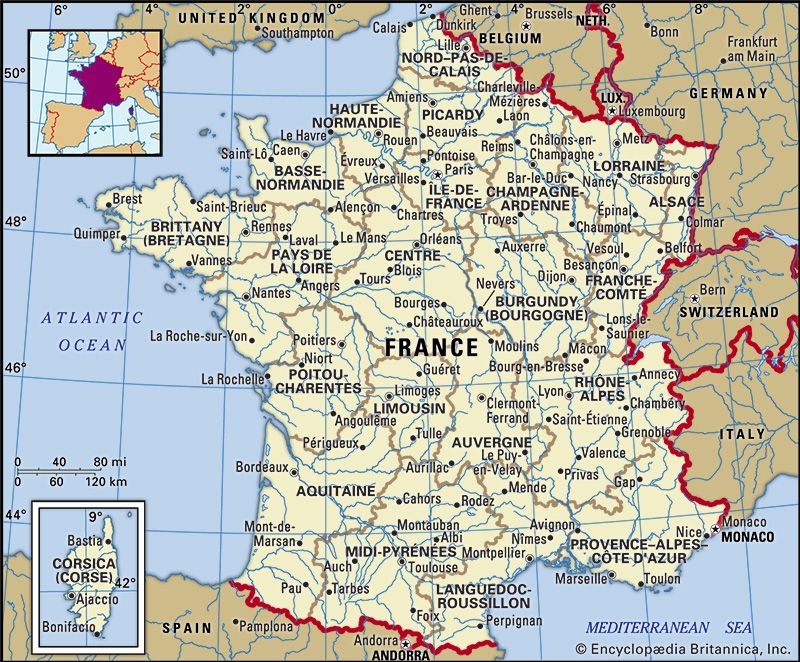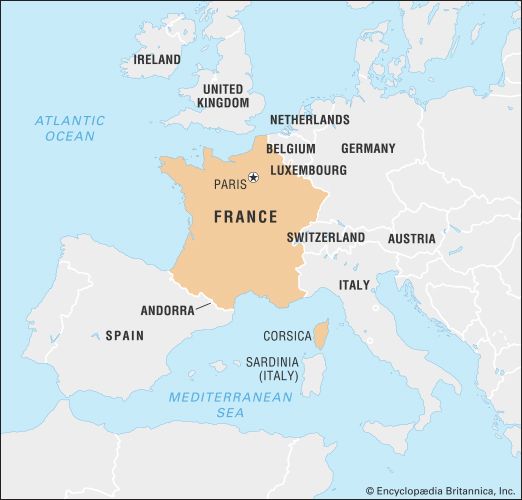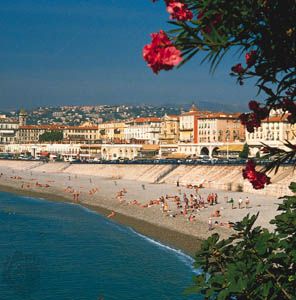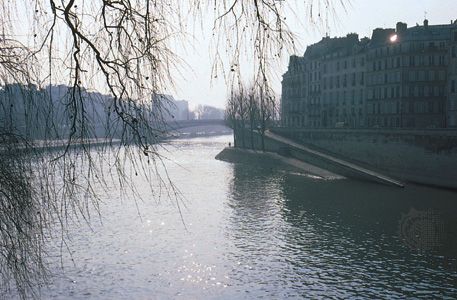- Merovingian and Carolingian age
- The emergence of France
- France, 1180 to c. 1490
- The French Revolution and Napoleon, 1789–1815
- France, 1815–1940
News •
Louis IX was succeeded by his son, Philip III (reigned 1270–85); his grandson, Philip IV (the Fair; 1285–1314); and three great-grandsons, Louis X (1314–16), Philip V (1316–22), and Charles IV (1322–28). The most significant of these last Capetian reigns was that of Philip the Fair. Worldly and ambitious yet pious and intelligent, he was less accommodating than his forebears and more devoted to his power than to his reputation. He brought the monarchy to a degree of coordinated strength it was not again to have in the Middle Ages. But, in so doing, he strained the resources and patience of his subjects. His sons had to give in to the demands of a country beginning to suffer from the natural disasters, such as the great famine and the Black Death, that would mark the 14th century. They did so, however, without abandoning their father’s objectives. When Charles IV died without a male heir in 1328, as his brothers had done before him, the royal succession was claimed by a collateral Capetian family.
The reigns of the later Capetian kings were marked by further territorial consolidation. Marrying his son to the heiress of Champagne and Navarra in 1284, Philip III prepared the way for a reversion no less important than that of Toulouse (1271). Philip the Fair secured the heiress to the county of Burgundy for his son Philip in 1295 and annexed southern Flanders and Lyon in 1312. Smaller acquisitions, cumulatively of great importance, resulted from purchase: the counties of Guînes (1281), Chartres (1286), and La Marche and Saintonge (1308); the viscounties of Lomagne and Auvillars (1302) and La Soule (1306); and a number of untitled lordships.
Through treaties, Philip the Fair extended his jurisdiction into the ecclesiastical principalities of Viviers, Cahors, Mende, and Le Puy. With his greatly expanded domain, the king could assert unprecedented authority everywhere in France. Yet it does not appear that territorial policy as such had changed. Appanages were still to be granted and to be recovered by the later Capetians. The monarchs continued to do without Brittany, Burgundy, and many lesser lordships, which did not prevent them from legislating for these lands along with the rest.
Government became more engrossing, specialized, and efficient. Although the royal curia continued to exist as an aggregate of favourites, magnates, prelates, and advisers, its ministerial element—comprising salaried officers serving at the king’s pleasure—functioned increasingly in departments. The small council acquired definition from an oath first mentioned in 1269. With its sessions lengthening under a growing burden of cases, Parlement was divided into chambers of pleas, requests, and investigations (1278), and its composition and jurisdiction were regulated. Older provincial tribunals, such as the Norman Exchequer and the Jours of Troyes, became commissions of Parlement. While the direction of finance was left with the council, the Chambre des Comptes (Chamber of Accounts), apart from the treasury, was organized to audit accounts. Council and chamber as well as Parlement developed appropriate jurisdiction, and all three bodies kept archives. The chancery, serving all departments, remained in the hands of lesser functionaries until 1315, when Louis X revived the title of honour.
Local administration was marked by the proliferation of officers subordinate to the bailiffs and seneschals. The chief judge (juge-mage) assumed the seneschal’s judicial functions in the south; receivers of revenues, first appearing in Languedoc, were instituted in the bailiwicks at the end of the 13th century. Commissions of investigation continued to traverse the provinces under the later Capetians, but all too often they now functioned as fiscal agents rather than as reformers.
Many of the officers who served Philip the Fair were laymen, and many were lawyers. Impressed with the power they wielded, they promoted loyalty to the crown and a conception of the royal authority approaching that of sovereignty. Without claiming absolute power for the king, they thought in terms of his “superiority” over all men within national boundaries now (for the first time) strictly determined; and they did not hesitate to argue from Roman law that, when the “state of the kingdom” was endangered, the monarch had an overriding right to the aid of all his subjects in its defense. While this doctrine, in a notorious case, was made a justification for imposing on the clergy, the later Capetians did not lose the religious mystique they had inherited from their predecessors’ efforts in Christian causes. Even as political loyalties were being engrossed by the lay state, the “religion of monarchy” derived impetus from the fervent utterance of those who saw in Philip the Fair a type of Christ or the ruler of a chosen and favoured people.
It was in the requirements of war and finance that the claims of the monarchy found most concrete expression. In the 1270s, for his campaigns in the south, Philip III requested military aid from men theretofore exempt from such service. Philip the Fair, renewing these demands for his wars in Gascony and Flanders, went so far as to claim the military obligation of all freemen as the basis for taxing personal property. The most persistent and lucrative taxation after 1285 was that imposed on the clergy, generally in the form of tithes (taxes on income) and annates (taxes on property); sales taxes, customs, tallages on Jews and foreign businessmen, and forced loans likewise supplemented older revenues of the domain to support increased administrative expenses as well as costs of war. The most unpopular fiscal expedients were the revaluations of coinage after 1295, by which the king several times increased the profits of his mints to the confusion of merchants and bankers. The imbalance between ordinary resources and the needs of an expanding government became chronic at the end of the 13th century. Yet, in spite of the statist arguments of their lawyers, none of the later Capetians were moved to regard taxation as an established and justified requirement of a national government.
Such restraint is one reason why, with momentary lapses, the strongest of the later Capetians was not regarded as an arbitrary ruler. Philip the Fair revered St. Louis (Louis IX) as much as did his people; like Louis, he took counsel from a relatively few unrepresentative persons. But, when Philip’s own policies broke with the past, he resorted to great councils and assemblies, not so much to commit the nation as to justify his course. Whether a tax was sanctioned by custom or not, even if approved by assembled magnates or townsmen, he had it negotiated—re-explained and collected—in the provinces and localities. Large central assemblies in 1302, 1303, 1308, and 1312 met to enable the king and his ministers to arouse political support for his measures against the pope or the Knights Templars.
Among these gatherings were the earliest national assemblies to include representatives of towns and villages, which has caused historians to see them as early versions of what became the Estates-General, meetings of deputies representing the clergy, the nobility, and the commoners of the entire kingdom that were convoked beginning in the 14th century. Under Philip the Fair and his sons, however, these convocations were not yet understood to be representative of the estates of society; only when Philip V began to summon northern and southern men separately to deliberate on fiscal matters were the estates (which made up the Estates-General) in any way anticipated. Almost simultaneously the provincial Estates were foreshadowed in the petitions of magnates and towns in several regions for relief from administrative violations of traditional privilege; but the resulting charters of 1314–15 were poorly coordinated. They did little to limit royal power, although the fiscal rights later claimed by the Estates of Normandy could be traced to the Norman Charter of 1315.
If the policies of Philip the Fair evoked the complaint of all classes of people, it was because he had favoured none in particular; in fact, except in war and finance, the later Capetians may be said to have maintained a traditional politics toward both the nobles and the towns. With the church, however, it was otherwise. Philip the Fair’s insistence on taxing the clergy for defense led immediately to his conflict with Pope Boniface VIII. The latter, in the bull Clericis laicos (1296), forbade the payment of taxes by clergymen to lay rulers without papal consent. Boniface had some support in the south, but Philip outmaneuvered the pope by prohibiting the export of bullion from France. The following year the pope abandoned his position and conceded to kings the right to tax the clergy without papal approval in time of need.
The quarrel was renewed in 1301, when the king and the magnates accused the bishop of Pamiers of treason and heresy. Boniface not only revoked the concessions of 1297 but rebuked Philip for seizing clerical property and debasing the coinage, among other things, and he summoned French prelates to Rome to proceed with a reform of the kingdom. Once again the clergy were split; many bishops and abbots attended an assembly at Paris in 1302 where they joined men of the other estates in addressing a remonstrance to the pope. A year later the king adopted rougher tactics: in June 1303 many prelates acquiesced in a scheme to try the pope before a general council, and in September the king’s envoy Guillaume de Nogaret and his accomplices seized Boniface at Anagni. Rescued by the Romans, the aged pope died a month later. Upon his death the papal monarchy that had been erected over the preceding two centuries collapsed entirely. The Gascon pope Clement V (reigned 1305–14) moved the Holy See to Avignon, and a mass of his compatriots were appointed cardinals.
With this pliant pontiff, the way was cleared for the strangest act of violence of the reign of Philip the Fair—the destruction of the Knights Templars. Founded in the 12th century, the Templars were an important Crusading order whose privileges seemed poorly justified after the fall of the last Crusader outpost in the Holy Land. The Templars remained an influential order, however, whose great wealth and power attracted Philip’s attention. In 1307 Philip ordered the arrest of every Templar in France and the seizure of their goods and property because of alleged heresy and immorality. Under torture, the Templars confessed to homosexual practices, spitting on the cross, idol worship, and other things. In 1310 many of the Templars recanted their confessions, but Philip proceeded in his quest against them and in 1312 persuaded the pope to formally suppress the order. Their last leaders were imprisoned for life, and the two highest-ranking authorities were burned at the stake.


























